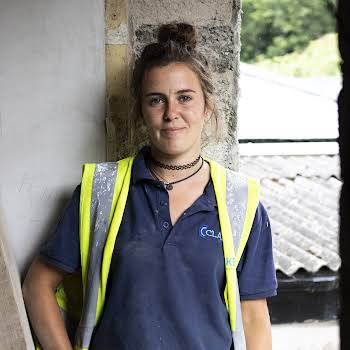
By Jeanne Sutton
22nd Apr 2014
22nd Apr 2014
Jane
If you’re a fixer, or know a fixer-upper type, then you’ll know why sugru is the cult product everyone is in love with. This self-setting rubber bonds to most other materials and is fast becoming a household name, and necessity. For the so-far uninitiated sugru is a soft and malleable material – it comes in many primary colours – that one can form by hand into any shape and overnight it turns into a strong, ?exible silicone rubber, helping repair and improve stuff you own and cherish. Think space age blu-tack that can fix a broken shelf in your fridge, replace the broken handle on your treasured mug and stop that iPad charger from fraying beyond use. Sugru is now used by nearly 300,000 people from 138 different countries around the world and it’s inventor?Jane ni Dhulchaointigh is one of our favourite entrepreneurs, with her down to earth attitude and complete honesty when it comes to running a start up. (Seriously, the company story on their nifty website is like the anti-The Social Network. So much joy and so much positivity among the early-days struggles.)
Jane invented sugru, or at least the concept of it, during her studies in the Royal College of Design, London, after study at NCAD and after British Airways featured sugru in their inflight magazine it all took off. Investors showed up and internet hype followed, eventually leading to TIME magazine declaring it on of The 50 Best Inventions of 2010. We caught up with Jane to talk inspiration, enterprise and explaining the word ?hack? to our mammies.
Jane invented sugru, or at least the concept of it, during her studies in the Royal College of Design, London, after study at NCAD and after British Airways featured sugru in their inflight magazine it all took off. Investors showed up and internet hype followed, eventually leading to TIME magazine declaring it on of The 50 Best Inventions of 2010. We caught up with Jane to talk inspiration, enterprise and explaining the word ?hack? to our mammies.
What has been your favourite use of sugru?
One I’ll never forget is when we heard from a canoeist in Canada called Joanne. For years she’d wanted to do this ultra-marathon race up the Yukon river, which is 700km long. The only problem was that she didn’t have any fingers on her left hand, and to canoe for this long she’d need to be able to paddle with both hands. She got a friend to help her modify her paddle with sugru so that she could get a good strong comfortable grip on it, and it helped her complete the race with her team in 3 days and 3 nights – straight paddling with no sleep. She said it was one of the best things she’s done in her life, and she couldn’t have done it if she hadn’t been able to modify her paddle. It’s an amazing example of a small fix making a big difference.
?Hack things better?? Can you explain what the word hack means to people like our mothers?
For us a hack is a clever solution to an everyday problem, but there have been many definitions, going back to 1961! It captures a strong can-do attitude that we hope inspires people to take control of their stuff, and make it work better for themselves. But we’re not particular about how people describe sugru – mending and modifying might describe it better for some!
You gave up chemistry in school and pursued design, and now you use the?chemistry all the time. Do you regret giving up chemistry? Do you feel there was not enough encouragement to do the sciences?
When I was in school, all subjects were pretty equally encouraged but my favourite subject was art. I loved biology too, and geography and languages. Maths, Chemistry and Physics were difficult for me, and I couldn’t understand them from a practical perspective – so I wasn’t able to stay interested. When Chemistry became relevant, in order to invent sugru, I found it much easier to learn, but having said that my knowledge of chemistry is super narrow!
When did you realise Sugru was to become your life?
I loved the idea from the very start, and I knew it had the potential to be very exciting and meaningful. But I had no idea how long it would take? if I did I probably would have been put off! I just took it a month at a time at the start, then a year at a time, and now it’s hard to think about what life would be like without it – the community of people we’ve built around it – whether it’s people who use sugru, or people I work with, inspire me every day.
You constantly refined the product and idea – what kept you going?
As soon as I had working samples from the lab, I started posting them out to people I’d met along the way for testing. They tried it out, and sent me back pictures of what they had done with it – the people ranged from my cousin who’s a chef, to a friend who’s a carpenter to another who surfs. The feedback helped me to make sugru work better – stick better to more materials etc but as well as that it worked as a sort of time-travel into the future – the fact that they were enjoying it so much and finding it so useful gave me a hint of what it would be like when sugru was out there properly!
Lego is famously the Danish for play. Sugru is inspired by the gaelic for play. Was that intentional?
You’re right! I didn’t even know that at the time I thought of the name sugru, but once we launched people pointed it out. I love LEGO so I don’t mind!
Is there another company out there that you admire?
I’m a huge admirer of all kinds of businesses that stand the test of time – brands that can be trusted and loved down through the generations. From global brands like LEGO to small family businesses we all know and love in our local area. In the start-up scene, I’m a big fan of brands that bravely disrupt an industry like Spotify and airbnb, and brands that manage to scale with strong ethics like Tom’s shoes and Patagonia clothing.
What has been your favourite milestone?
Launching! What a relief to see people getting excited and using sugru!
You’re curating the Fail Better exhibition in the Science Gallery – what is your approach to failure?
Failure is something that’s still taboo for a lot of people – particularly young people. Life is full of surprises, you never really know what’s going to happen next and so much of it is outside your control. I hope that by having more of a conversation around failure, that more people will be encouraged to give things a go. I had no idea that I would invent sugru – it’s only by failing at being an artist that I signed up to study design, and it was only by failing at design that I ended up playing with materials – it’s our failures that get us places.
What has been your favourite failure? Which one could you have done without?
Early on in the making of sugru, we had a problem with a batch. We spotted it super early, before our customers, and sent out replacements. It was really scary and I had so many sleepless nights over it because when you’re at such an early stage, every customer matters.
In the end, everyone affected was so understanding and grateful for the way we took care of them, I think they even loved us a little bit more. That taught me that your product is only one small part of the business, the way you treat your customers might make the difference between a fad and a company that builds and grows into a household brand.
Sugru was almost derailed by the recession – talk us through that time.
In 2008 our funding was running low, but there was still a long way to go with development. If we’d thought getting investment was hard before, now the recession meant that it was almost impossible. It was a real low point: we pitched to almost 100 investors with no luck.
We did at last get an investment in 2009 of just enough money to launch sugru ourselves. But if I hadn’t had the conviction that sugru was important enough to succeed, it might have been tempting to pack it all in when things got really tough. Once we got the money we set ourselves a deadline of 6 months to launch. I’d made a new year’s resolution to stop listening to other people’s advice and go with my gut, and I think it was one of the most important decisions I ever made. We did everything ourselves, from building the machines to making and packing every last pack of sugru. When our first 1000 packs sold out in 6 hours, we knew we were on the road properly again.
What is the one quality one needs to survive as an entrepreneur?
Optimism!
Here at Image.ie we love your Fixers Manifesto. What is your favourite quote, not contained within that work?
It’s more fun to be a pirate than to join the army – Steve Jobs
The market for something to believe in is infinite – Hugh McCleod
How do you take a break from all the Grown-Up Mala?
Cycle my bike, walk my dog or have a pint!
Jeanne Sutton @jeannedesutun


























